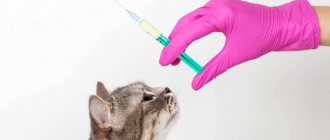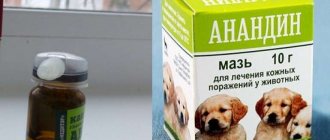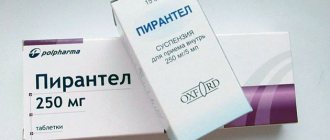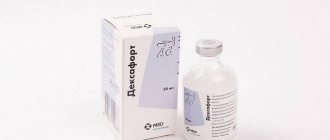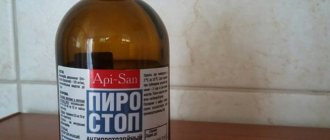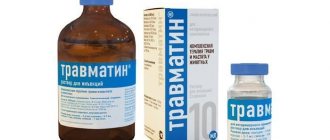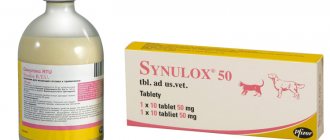Composition of the drug
The main active ingredient of Clamoxil is 15% amoxicillin trihydrate. It has a prolonged, cumulative, complex, rapid bactericidal effect. 1 ml of suspension contains 150 mg of amoxicillin. Refers to semisynthetic penicillin antibiotics.
Effective against most types of gram-positive and gram-negative bacteria (streptostaphylococci, salmonella, proteus, corynebacteria, etc.). Destroys the cell membranes of parasites, which leads to their death. Inactive against bacteria that produce beta-lactomase.
After parenteral administration (intramuscular, subcutaneous), amoxicillin is gradually absorbed from the injection site, quickly spreads through the bloodstream to the internal organs, and easily penetrates the tissues.
In addition to the main active ingredient, the drug contains excipients:
- phenol – 5 mg;
- aluminum stearate – 16 mg;
- Fractionated coconut oil – 1 ml.
After administration, the active component of Clamoxil is therapeutically effective for 48 hours. In this case, the maximum concentration of the active substance is noted two hours after the injection of the drug.
Clamoxil is a complex antibiotic that is safe for dogs. Does not have a teratogenic or toxic effect. It is excreted unchanged from the body of animals with urine and bile.
Similar medical products
An absolute analogue of the Clamoxyl injection suspension is the drug Amoxicillin, which is available in the form of tablets and powder. It has a detrimental effect on various types of pathogenic microorganisms, however, there are bacteria that are resistant to the action of this antibiotic. Clamoxil also has other analogues:
The animal's condition can return to normal after Lincomycin.
- "Sinulox";
- "Gentamicin";
- "Sulf-120";
- "Sincomycin";
- "Amoxoil retard";
- "Baytril";
- "Doreen";
- "Kobaktan";
- "Stomorgil";
- "Lincomycin."
Storage conditions
To ensure that the veterinary drug does not lose its effect and effectiveness, it is necessary to comply with storage conditions and transportation rules.
Store Clamoxil in a closed bottle, out of the reach of children and animals at a temperature of 3 to 23 degrees Celsius. Protect the drug from direct sunlight and bright light.
Subject to storage conditions, Clamoxil should be used to treat animals for three years from the date of release. After opening, the bottle is stored in its original packaging in a cool, dark place. The uncorked, non-hermetically sealed medicine must be used within 27-28 days.
After the expiration date, the medicine is disposed of.
pharmachologic effect
Amoxicillin, which is a broad-spectrum antibiotic, has an effect against pathogenic microorganisms, including: Arcanobacteria, Corynebacterium, Haemophilus influenzae, Pasteurella, Enterobacteriaceae, Mirabilis, Salmonella, small diplobacteria, polymorphic rods and Brachyspira, which causes dysentery, as well as other common bacteria. A penicillin component, penetrating into the body of a sick animal, stops the synthesis of bacterial cells, disrupts their growth and reproduction, and blocks vital processes. Microbes die at the very beginning of their development, before they have time to spread.
The drug begins to act 120 minutes after administration and continues to be active inside the patient’s body for 18 hours.
The duration of the pharmacological action of the suspension is achieved due to the oily base. The component gradually releases micronized amoxicillin into the cat’s blood, which is absorbed by the body even more easily and quickly. Clamoxil leaves the pet's body unchanged. The excretion process involves the patient’s urinary system and gastrointestinal tract.
Clamoxil LA: indications for use
Indications for the use of Clamoxil are indicated in the annotation for the veterinary drug. Therefore, before use, not only consult a veterinarian, but also carefully read the instructions from the manufacturer.
Indications for use:
- treatment of diseases of viral and bacterial etiology;
- in the treatment of upper respiratory tract infections (otitis, pneumonia, bronchopneumonia, rhinitis);
- purulent, infected wounds;
- umbilical infections;
- gastrointestinal infections (enteritis);
- soft tissue diseases
- diseases of the genitourinary system (cystitis, metritis, pyelonephritis);
- treatment of dermatitis, dermatoses, skin infections (abscesses, cellulitis, necrobacteriosis);
- inflammatory joint diseases;
- for acute, chronic inflammatory processes in the dog’s body.
Clamoxil is also often prescribed by veterinarians after surgical procedures and operations for prophylactic purposes to prevent postoperative infections.
Negative phenomena
An allergic reaction to the drug may result in severe itching in the animal.
If you strictly follow the veterinarian's recommendations and the manufacturer's instructions, the chance of developing side symptoms is minimal. In exceptional cases, during treatment with Clamoxil, signs of allergy may occur, manifested in the form of redness of the skin, especially at the injection site, swelling and itching. In addition, when studying the medicine, it was noticed that cats with an allergy to it may experience baldness, anaphylactic shock and difficulty breathing. If such negative effects develop, you should stop therapy and consult a veterinarian to find a replacement for Clamoxyl.
Instructions for use of Clamoxil
The instructions for use of Clamoxil state that the veterinary drug is intended exclusively for intramuscular, subcutaneous administration.
Important! Follow the dosage prescribed by your veterinarian. Do not interrupt the course of treatment. Otherwise, the treatment will not give a positive result.
The duration of the treatment course depends on the stage and degree of the viral-bacterial disease. For mild forms of infection, one injection is sufficient, since the veterinary drug not only has a rapid antibacterial effect, but also has a prolonged effect. In severe advanced cases, the dog is given two or three injections.
Shake the bottle well before injection. Use sterile disposable syringes. Make sure that the medicine does not get on the mucous membranes or in the oral cavity.
Price
The antibiotic Clamoxil, intended for use in veterinary medicine, is sold in 100 ml bottles. It can be purchased in pet stores from 700 rubles. However, the composition may cost more, since its final price depends on several factors: retail markup, type of manufacturer, delivery conditions.
Subcutaneous injection for a cat
Visit the profile section of our Medical Examination forum or leave your feedback in the comments below. More opinions means more useful information, it will be useful to someone. If there are good and interesting videos on the topic of the article, write and I will insert them into this publication.
Side effects
Clamoxil, as already noted, is not only effective, but also an absolutely safe, non-toxic veterinary drug for dogs and other pets. It is prescribed for dogs of different ages and breeds.
Important! Treatment with Clamoxil for puppies, lactating bitches, and weakened animals is carried out only under the supervision of a veterinarian.
When testing the treatment of dogs with Clamoxylov, side effects were noted extremely rarely and only in the case of the individual sensitivity of the animal’s body to the constituent components.
Uncharacteristic reactions may include the appearance of a slight swelling at the injection site. The swelling goes away on its own on the second day.
In case of hypersensitivity, the dog may develop drooling, allergic manifestations, and disturbances in the digestive tract (vomiting, nausea, diarrhea). Possible decrease in activity, drowsiness, depression, temporary refusal of food.
As a rule, adverse reactions, if there is no severe allergy, disappear within two days from the moment of administration of the veterinary drug. But still, to avoid side symptoms, consult your veterinarian before using Clamoxil.
In case of allergies, dogs are prescribed antihistamines and detoxification therapy is carried out. In the future, the veterinarian will prescribe another antibacterial agent.
Reviews from dog owners
Georgy, Perm. Clamoxil injections were prescribed to my Caucasian Shepherd after a severe injury (he was injured in a fight). At first they treated him with another antibiotic, but the inflammatory process did not stop, and the dog began to have severe stomach upset and began to refuse to eat. But Clamoxil did not have such a wild reaction, the dog began to slowly recover. 3 injections were enough, however, after treatment I had to restore the intestinal microflora. But this is a normal reaction to an antibiotic. And so, I think that it was these injections that saved the dog.
Anna, Moscow. My old Dalmatian has chronic cystitis, which gets worse periodically. The doctor prescribed Clamoxil subcutaneously, I did it myself. It seemed to help, the main thing is that there were no side effects. Dogs often have a bad reaction to antibiotics, but this one was pretty mild. I’ll keep it in mind, there will probably be exacerbations, so I’ll have to inject again. Yes, for everything to go well, you need to strictly follow the course. If it is interrupted, there will be no benefit, but harm is quite possible.
Contraindications
Despite the fact that Clamoxil is a safe, non-toxic veterinary drug, there are some contraindications for its use, which are indicated in the annotation.
Clamoxil is not prescribed:
- whelping bitches in the last and first trimester of pregnancy;
- animals that are intolerant to penicillin antibiotics;
- lactating bitches in the first two weeks after the birth of puppies;
- puppies up to 2-3 weeks of age.
Clamoxil is not used in the treatment of small rodents and herbivores (rabbits, hamsters, mice).
It is strictly forbidden to mix this veterinary drug in the same syringe with other medications.
It is not recommended to use bait for viral-bacterial diseases caused by bacteria that produce penicillinase.
Release forms
The forms of release of the drug do not differ in variety. The antibiotic Clamoxil is produced in the form of a suspension (suspension). The color of the contents is usually whitish, but sometimes has a light cream or light yellow tint.
Important! The presence of small sediment at the bottom is normal. It is not considered a sign of damage or defect.
The suspension is packaged in glass bottles containing 100 ml of the drug. To ensure tightness, the bottles are tightly closed with stoppers and foil. This ensures the solution is sterile.
Analogues of Clamoxil
If for some reason it is not possible to buy this drug, its analogues may be prescribed by a veterinarian:
- Sinulox.
- Dorin.
- Baytril.
- Gentamicin.
- Kobaktan.
- Lincomycin.
In general, any antibacterial agents based on amoxicillin can be used as analogues in the treatment of infections. But before you carefully read the instructions for it, consult with your veterinarian regarding the dosage and duration of the treatment course.
Pregnant, lactating and kittens
The drug is not recommended for the treatment of pregnant animals, especially if there is very little time left before birth. The antibiotic negatively affects future offspring. An exception is made for those females who are in poor condition. In this case we are talking about the life of an animal.
You should not give injections with this antibiotic to nursing cats. The drug is prescribed to kittens with caution in cases where the critical condition of the animal requires it. The dose is calculated only by a specialist.
